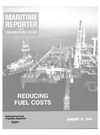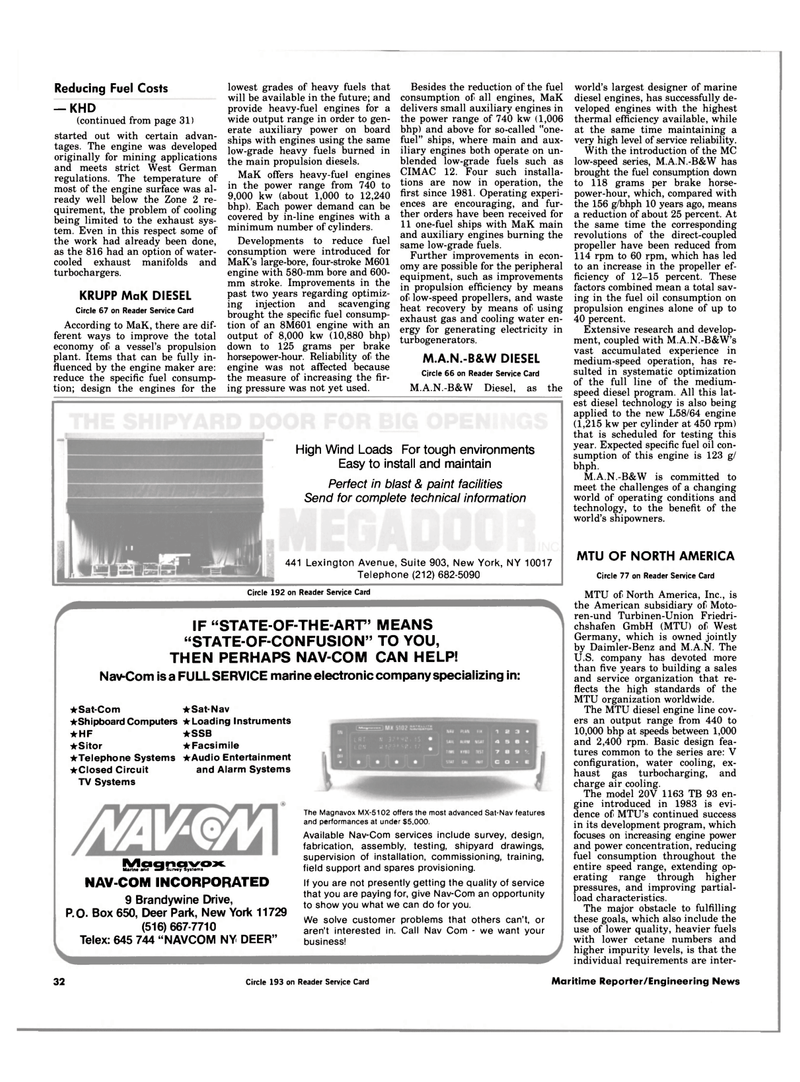
Page 30: of Maritime Reporter Magazine (January 15, 1984)
Read this page in Pdf, Flash or Html5 edition of January 15, 1984 Maritime Reporter Magazine
Reducing Fuel Costs — KHD (continued from page 31) started out with certain advan- tages. The engine was developed originally for mining applications and meets strict West German regulations. The temperature of most of the engine surface was al- ready well below the Zone 2 re- quirement, the problem of cooling being limited to the exhaust sys- tem. Even in this respect some of the work had already been done, as the 816 had an option of water- cooled exhaust manifolds and turbochargers.
KRUPP MaK DIESEL
Circle 67 on Reader Service Card
According to MaK, there are dif- ferent ways to improve the total economy of a vessel's propulsion plant. Items that can be fully in- fluenced by the engine maker are: reduce the specific fuel consump- tion; design the engines for the lowest grades of heavy fuels that will be available in the future; and provide heavy-fuel engines for a wide output range in order to gen- erate auxiliary power on board ships with engines using the same low-grade heavy fuels burned in the main propulsion diesels.
MaK offers heavy-fuel engines in the power range from 740 to 9,000 kw (about 1,000 to 12,240 bhp). Each power demand can be covered by in-line engines with a minimum number of cylinders.
Developments to reduce fuel consumption were introduced for
MaK's large-bore, four-stroke M601 engine with 580-mm bore and 600- mm stroke. Improvements in the past two years regarding optimiz- ing injection and scavenging brought the specific fuel consump- tion of an 8M601 engine with an output of 8,000 kw (10,880 bhp) down to 125 grams per brake horsepower-hour. Reliability of the engine was not affected because the measure of increasing the fir- ing pressure was not yet used.
Besides the reduction of the fuel consumption of all engines, MaK delivers small auxiliary engines in the power range of 740 kw (1,006 bhp) and above for so-called "one- fuel" ships, where main and aux- iliary engines both operate on un- blended low-grade fuels such as
CIMAC 12. Four such installa- tions are now in operation, the first since 1981. Operating experi- ences are encouraging, and fur- ther orders have been received for 11 one-fuel ships with MaK main and auxiliary engines burning the same low-grade fuels.
Further improvements in econ- omy are possible for the peripheral equipment, such as improvements in propulsion efficiency by means of low-speed propellers, and waste heat recovery by means of using exhaust gas and cooling water en- ergy for generating electricity in turbogenerators.
M.A.N.-B&W DIESEL
Circle 66 on Reader Service Card
M.A.N.-B&W Diesel, as the
High Wind Loads For tough environments
Easy to install and maintain
Perfect in blast & paint facilities
Send for complete technical information 441 Lexington Avenue, Suite 903, New York, NY 10017
Telephone (212) 682-5090
Circle 192 on Reader Service Card
IF "STATE-OF-THE-ART' MEANS "STATE-OF-CON FUSION" TO YOU,
THEN PERHAPS NAV-COM CAN HELP!
Nav-Com is a FULL SERVICE marine electronic company specializing in: •Sat-Com *Sat-Nav •ShipboardComputers •Loading Instruments •HF *SSB •Sitor ^Facsimile •Telephone Systems •Audio Entertainment •Closed Circuit and Alarm Systems
TV Systems
Maqnavox
Marine and Survey Systems
NAV-COM INCORPORATED 9 Brandywine Drive,
P.O. Box 650, Deer Park, New York 11729 (516) 667-7710
Telex: 645 744 "NAVCOM NY DEER"
The Magnavox MX-5102 offers the most advanced Sat-Nav features and performances at under $5,000.
Available Nav-Com services include survey, design, fabrication, assembly, testing, shipyard drawings, supervision of installation, commissioning, training, field support and spares provisioning.
If you are not presently getting the quality of service that you are paying for, give Nav-Com an opportunity to show you what we can do for you.
We solve customer problems that others can't, or aren't interested in. Call Nav Com - we want your business! world's largest designer of marine diesel engines, has successfully de- veloped engines with the highest thermal efficiency available, while at the same time maintaining a very high level of service reliability.
With the introduction of the MC low-speed series, M.A.N.-B&W has brought the fuel consumption down to 118 grams per brake horse- power-hour, which, compared with the 156 g/bhph 10 years ago, means a reduction of about 25 percent. At the same time the corresponding revolutions of the direct-coupled propeller have been reduced from 114 rpm to 60 rpm, which has led to an increase in the propeller ef- ficiency of 12-15 percent. These factors combined mean a total sav- ing in the fuel oil consumption on propulsion engines alone of up to 40 percent.
Extensive research and develop- ment, coupled with M.A.N.-B&W's vast accumulated experience in medium-speed operation, has re- sulted in systematic optimization of the full line of the medium- speed diesel program. All this lat- est diesel technology is also being applied to the new L58/64 engine (1,215 kw per cylinder at 450 rpm) that is scheduled for testing this year. Expected specific fuel oil con- sumption of this engine is 123 g/ bhph.
M.A.N.-B&W is committed to meet the challenges of a changing world of operating conditions and technology, to the benefit of the world's shipowners.
MTU OF NORTH AMERICA
Circle 77 on Reader Service Card
MTU of North America, Inc., is the American subsidiary of Moto- ren-und Turbinen-Union Friedri- chshafen GmbH (MTU) of West
Germany, which is owned jointly by Daimler-Benz and M.A.N. The
U.S. company has devoted more than five years to building a sales and service organization that re- flects the high standards of the
MTU organization worldwide.
The MTU diesel engine line cov- ers an output range from 440 to 10,000 bhp at speeds between 1,000 and 2,400 rpm. Basic design fea- tures common to the series are: V configuration, water cooling, ex- haust gas turbocharging, and charge air cooling.
The model 20V 1163 TB 93 en- gine introduced in 1983 is evi- dence of MTU's continued success in its development program, which focuses on increasing engine power and power concentration, reducing fuel consumption throughout the entire speed range, extending op- erating range through higher pressures, and improving partial- load characteristics.
The major obstacle to fulfilling these goals, which also include the use of lower quality, heavier fuels with lower cetane numbers and higher impurity levels, is that the individual requirements are inter- 32 Circle 193 on Reader Service Card Maritime Reporter/Engineering News

 29
29

 31
31
